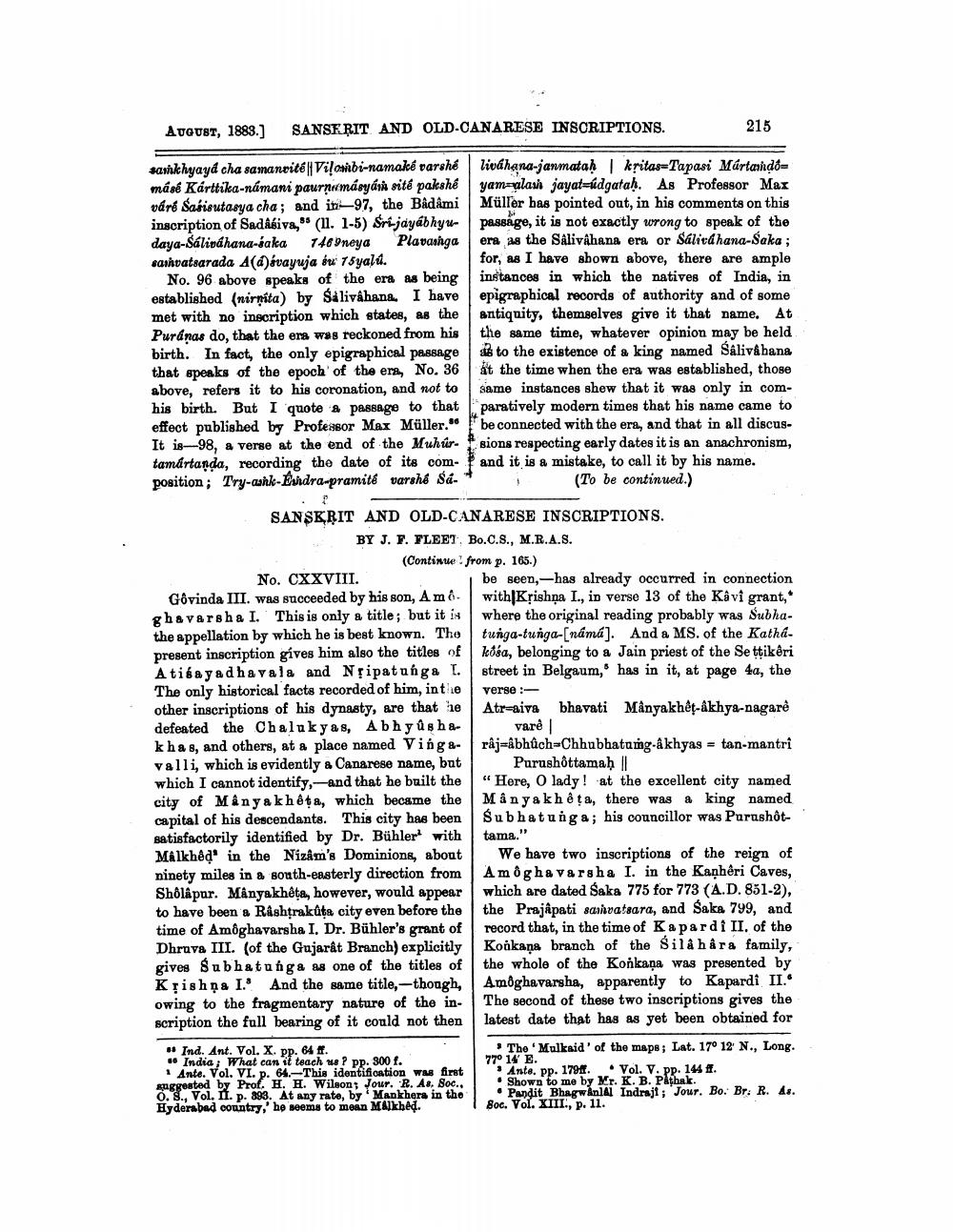________________
SANSERIT AND OLD-CANARESE INSCRIPTIONS.
AUGUST, 1883.]
samkhyaya cha samanvité || Vilombi-namaké varshé másé Kárttika-námani paurnumásyám sité pakshe váré Sasisutasya cha; and in-97, the Bâdâmi inscription of Sadasivas (11. 1-5) Sri-jayabhyudaya-Sáliváhana-saka 7469neya Plavashga samvatsarada A(á)svayuja su 75yalú.
No. 96 above speaks of the era as being established (nirrita) by Salivahana. I have met with no inscription which states, as the Puranas do, that the era was reckoned from his birth. In fact, the only epigraphical passage that speaks of the epoch of the era, No. 36 above, refers it to his coronation, and not to his birth. But I quote a passage to that effect published by Professor Max Müller." It is 98, a verse at the end of the Muhurtamartanda, recording the date of its composition; Try-ashk-Endra-pramité varshé Sá
SANSKRIT AND OLD-CANARESE INSCRIPTIONS.
BY J. F. FLEET, Bo.C.S., M.R.A.S. (Continue from p. 165.)
No. CXXVIII.
Govinda III. was succeeded by his son, Amôghavarsha I. This is only a title; but it is the appellation by which he is best known. The present inscription gives him also the titles of Atifayadhavals and Nripatungs T The only historical facts recorded of him, in the other inscriptions of his dynasty, are that he defeated the Chalukyas, Abhyûshakhas, and others, at a place named Vingavalli, which is evidently a Canarese name, but which I cannot identify, and that he built the city of Manyak hêta, which became the capital of his descendants. This city has been satisfactorily identified by Dr. Bühler with Malkhed in the Nizâm's Dominions, about ninety miles in a south-easterly direction from Shôlâpur. Mânyakhêta, however, would appear to have been a Rashtrakuta city even before the time of Amôghavarsha I. Dr. Bühler's grant of Dhruva III. (of the Gujarât Branch) explicitly gives Subhatunga as one of the titles of Krishna I. And the same title,-though, owing to the fragmentary nature of the inscription the full bearing of it could not then
ss Ind. Ant. Vol. X. pp. 64 ff. so India; What can it teach us? pp. 300 f.
Ante. Vol. VI. p. 64.-This identification was first suggested by Prof. H. H. Wilson; Jour. R. As, Soc.. O. S., Vol. II. p. 393. At any rate, by Mankhera in the Hyderabad country,' he seems to mean Malkhed.
215
liváhana-janmataḥ | kritas-Tapasi Mártamḍô= yam-alash jayat-údgataḥ. As Professor Max Müller has pointed out, in his comments on this passage, it is not exactly wrong to speak of the era as the Salivahana era or Sáliváhana-Saka; for, as I have shown above, there are ample instances in which the natives of India, in epigraphical records of authority and of some antiquity, themselves give it that name. At the same time, whatever opinion may be held
to the existence of a king named Salivahana at the time when the era was established, those same instances shew that it was only in comparatively modern times that his name came to be connected with the era, and that in all discussions respecting early dates it is an anachronism, and it is a mistake, to call it by his name. (To be continued.)
be seen, has already occurred in connection with Krishna I., in verse 13 of the Kâvi grant,* where the original reading probably was Subhatunga-tunga-[námá]. And a MS. of the Kathakosa, belonging to a Jain priest of the Seṭṭikêri street in Belgaum, has in it, at page 4a, the
verse:
Atr-aiva bhavati Mânyakhêt-âkhya-nagare varê |
raj-abhuch-Chhubhatumg-akhyas tan-mantri Purushottamaḥ ||
"Here, O lady! at the excellent city named Mânyakheta, there was a king named Subhatunga; his councillor was Purushôt
tama."
We have two inscriptions of the reign of Amôghavarsha I. in the Kanhêri Caves, which are dated Śaka 775 for 773 (A.D. 851-2), the Prajapati samvatsara, and Saka 799, and record that, in the time of Kapardi II. of the Konkana branch of the Sila håra family, the whole of the Konkana was presented by Amôghavarsha, apparently to Kapardi II. The second of these two inscriptions gives the latest date that has as yet been obtained for
The 'Mulkaid' of the maps; Lat. 17° 12' N., Long. 770 14' E.
Ante. pp. 179.
Vol. V. pp. 144 ff. Shown to me by Mr. K. B. Pathak.
Pandit Bhagwanlal Indraji; Jour. Bo. Br. R. As. Soc. Vol. XIII., p. 11.




